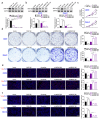RING finger gene 180 inhibits osteosarcoma progression through regulating chromobox homolog 4 ubiquitination
- PMID: 37095741
- PMCID: PMC10193903
- DOI: 10.1080/15384101.2023.2205201
RING finger gene 180 inhibits osteosarcoma progression through regulating chromobox homolog 4 ubiquitination
Abstract
Osteosarcoma (OS) is still the most common malignant bone tumor whose etiology remains largely unclear. Here, we aimed to investigate the role of a novel E3 ubiquitin ligase RING finger gene 180 (RNF180) in OS progression. RNF180 was significantly down-regulated in both OS tissues and cell lines. We up-regulated RNF180 using over-expression vector and knocked down RNF180 using specific short hairpin RNAs in OS cell lines. RNF180 over-expression inhibited the viability and proliferation yet promoted apoptosis in OS cells, while RNF180 knockdown showed the opposite effects. RNF180 also suppressed tumor growth and lung metastasis in mouse model, accompanied with elevated E-cadherin level and decreased ki-67 level. Besides, chromobox homolog 4 (CBX4) was predicted as a substrate of RNF180. RNF180 and CBX4 were both localized mainly in nucleus and their interaction was validated. RNF180 aggravated the decline of CBX4 level after cycloheximide treatment. RNF180 also promoted the ubiquitination of CBX4 in OS cells. Furthermore, CBX4 was significantly up-regulated in OS tissues. RNF180 also up-regulated Kruppel like factor 6 (KLF6) yet down-regulated RUNX family transcription factor 2 (Runx2) in OS, which served as downstream targets of CBX4. In addition, RNF180 inhibited migration, invasion and epithelial-mesenchymal transition (EMT) in OS cells, which were partially abolished by CBX4 over-expression. In conclusion, our findings demonstrated that RNF180 inhibits OS development via regulating CBX4 ubiquitination, and RNF180-CBX4 axis is a potential therapeutic target for OS treatment.
Keywords: CBX4; Osteosarcoma; RNF180; migration and invasion; ubiquitination.
Conflict of interest statement
No potential conflict of interest was reported by the authors.
Figures







Similar articles
-
Targeting the CK1α/CBX4 axis for metastasis in osteosarcoma.Nat Commun. 2020 Feb 28;11(1):1141. doi: 10.1038/s41467-020-14870-4. Nat Commun. 2020. PMID: 32111827 Free PMC article.
-
Ziyuglycoside II, a triterpene glycoside compound in Sanguisorbae officinalis l. extract, suppresses metastasis in osteosarcoma via CBX4-mediated Wnt/β-catenin signal pathway.Phytomedicine. 2024 Sep;132:155716. doi: 10.1016/j.phymed.2024.155716. Epub 2024 May 9. Phytomedicine. 2024. PMID: 38924929
-
MicroRNA-488 inhibits proliferation, invasion and EMT in osteosarcoma cell lines by targeting aquaporin 3.Int J Oncol. 2018 Oct;53(4):1493-1504. doi: 10.3892/ijo.2018.4483. Epub 2018 Jul 16. Int J Oncol. 2018. Retraction in: Int J Oncol. 2023 Feb;62(2):18. doi: 10.3892/ijo.2022.5466. PMID: 30015825 Free PMC article. Retracted.
-
The Roles of CBX4 in Gastrointestinal Cancer.Discov Med. 2025 May;37(196):828-840. doi: 10.24976/Discov.Med.202537196.73. Discov Med. 2025. PMID: 40415358 Review.
-
Protein Stability Regulation in Osteosarcoma: The Ubiquitin-like Modifications and Glycosylation as Mediators of Tumor Growth and as Targets for Therapy.Cells. 2024 Mar 18;13(6):537. doi: 10.3390/cells13060537. Cells. 2024. PMID: 38534381 Free PMC article. Review.
Cited by
-
RNF135 Promotes Human Osteosarcoma Cell Growth and Inhibits Apoptosis by Upregulating the PI3K/AKT Pathway.Cancer Rep (Hoboken). 2024 Aug;7(8):e2159. doi: 10.1002/cnr2.2159. Cancer Rep (Hoboken). 2024. PMID: 39118262 Free PMC article.
-
RNF180 weakened the lipid droplet formation and subsequent chemoresistance by destabilizing ACC1 and ACLY in esophageal cancer.Front Pharmacol. 2025 Apr 22;16:1525431. doi: 10.3389/fphar.2025.1525431. eCollection 2025. Front Pharmacol. 2025. PMID: 40331188 Free PMC article.
-
Unravelling the impact of the chromobox proteins in human cancers.Cell Death Dis. 2025 Apr 2;16(1):238. doi: 10.1038/s41419-025-07585-1. Cell Death Dis. 2025. PMID: 40175347 Free PMC article. Review.
-
KLX ameliorates liver cancer progression by mediating ZBP1 transcription and ubiquitination and increasing ZBP1-induced PANoptosis.Acta Pharmacol Sin. 2025 Aug;46(8):2282-2295. doi: 10.1038/s41401-025-01528-4. Epub 2025 Mar 27. Acta Pharmacol Sin. 2025. PMID: 40148674 Free PMC article.
-
Ubiquitination in osteosarcoma: unveiling the impact on cell biology and therapeutic strategies.Cancer Biol Med. 2024 Oct 30;21(10):880-97. doi: 10.20892/j.issn.2095-3941.2024.0231. Cancer Biol Med. 2024. PMID: 39475222 Free PMC article. Review.
References
-
- Ritter J, Bielack S. S.. Osteosarcoma. Ann Oncol. 2010;21(Suppl 7):vii320–5. - PubMed
-
- Dahlin DC. Pathology of osteosarcoma. Clin Orthop Relat Res. 1975. (111):23–32. - PubMed
-
- Ogawa M, Mizugishi K, Ishiguro A, et al. Rines/RNF180, a novel RING finger gene-encoded product, is a membrane-bound ubiquitin ligase. Genes to Cells. 2008;13(4):397–409. - PubMed
MeSH terms
Substances
LinkOut - more resources
Full Text Sources
Medical
Molecular Biology Databases
